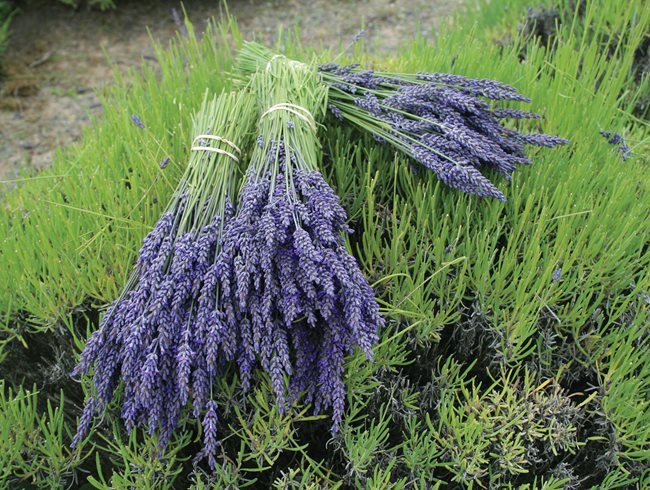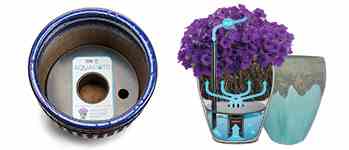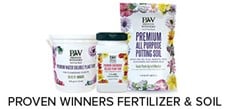How to Preserve Herbs by Drying or Freezing
An excerpt from The Herb Lover’s Spa Book (St. Lynn’s Press)Gathering herbs at the end of the season is vital to keeping supplies available after the garden has gone quiet for the winter. To get the best of the garden in the preservation process, take good care to harvest at the right time and dry the plant materials carefully.

Bundle sturdy stemmed herbs like lavender (pictured) with a rubber band and hang to dry. Photo by: Sue Goetz.
PRESERVATION TIPS
- As with fresh harvesting through the growing season, it is best to harvest them in the morning after the dew dries.
- When summer wanes and fall begins, keep an eye on herbaceous perennials that are fading. Harvest herbs when they still look good and not when the foliage is drying or turning brown.
- Keep watch on the weather and as first frost is approaching, make sure to harvest any tender or annual plants before they are killed by the cold. The time you take at harvest and preserving is part of your own quality control and will provide you with herbs in every month of the year.
- Consider the shelf life of dried or frozen herbs as “harvest to harvest.” Use up herbs before the next season is harvested so the supply is never more than a year old.
- Store dried herb in glass jars and keep in a cabinet away from sun and heat.
- Label all the jars with the herb name and harvest date, herbs look alike after they are dried.
HANG DRY
This is the most popular way to preserve herbs from the garden.
What to do: Dry them in a dark, airy place. Make sure they are not in direct sunlight and have good air circulation around them. Bundle them with rubber bands and hang them upside down. To remove leaves or flowers from dried stems, simply strip the dried plants from the stems or shake into a paper bag until the stems are cleaned, then empty the bag into a spice jar. Leaves and seeds should be kept whole, to be crushed down when needed.

Your herb drying space should have good air circulation without direct sunlight. Photo by: Sue Goetz.
FREEZE
An alternative to drying herbs is to freeze them. Some, not all, herbs will retain their properties when frozen. The freezing process will darken leaves and change the look of the herbs, but will hardly be noticeable when blended into mixes or added into hot liquids.
What to do: Harvest and rinse in cool water and pat dry. Remove the leaves and flowers from the stiff stems. Use sharp scissors and cut them up. Sprinkle them over a cookie sheet and put them in the freezer for about an hour. Put in freezer bags and return to the freezer. This method allows you to sprinkle them into recipes instead of freezing them in a big clump.

Herbs that freeze well include (clockwise from left) basil, parsley, lemon verbena, and mint. Photos by: Courtney Goetz.
WINTER SOLSTICE RECIPE
In mid-December, the winter solstice marks when the day is the shortest and the sun begins its slow progress to give longer daylight. We become meditative, stay inside and feel like we want to hibernate. Relying on herbs harvested and preserved from summer, skin treatments relieve dry skin. Bathing in herbs encourages positive meditation in this introspective time to spark a renewal as nature works her way to spring.

The vibrant orange and yellow petals of calendula, used in spa blends, are healing and soothing to skin. Photo by: Sue Goetz.
Calendula Salve
Healing and colorful, this salve is pure and simple to soothe hands, elbows, and rough patches of skin worn by the drying effects of indoor heat.
1 cup dried calendula petals
1 cup olive or avocado oil
1 tablespoon beeswax
1 Vitamin E capsule
What to do:
- Pour the oil into a clean, sterilized glass jar. Add calendula petals to oil and snip floating petals to break up larger pieces.
- Cover the jar and allow to sit for two weeks, shake occasionally.
- Optional: You can speed up the process by warming the calendula petal/oil mix. Microwave for a minute or until the oil is warm (not burning hot). The heat will release the properties of the calendula into the oil. Allow to cool before use.
- When the oil is ready, filter out the petals through a strainer or cheesecloth. Pierce the Vitamin E capsule and squeeze into the oil, mix well. Set aside.
- Slowly melt beeswax in a glass saucepan over low heat, until fully liquefied. Remove from heat and slowly pour in the calendula oil, stirring until the mix is blended and just begins to harden.
- Pour into small wide-mouthed tins or jars. Cover.
Buy The Herb Lovers Spa Book on Amazon.com.
RELATED:
How to Start an Herb Garden




